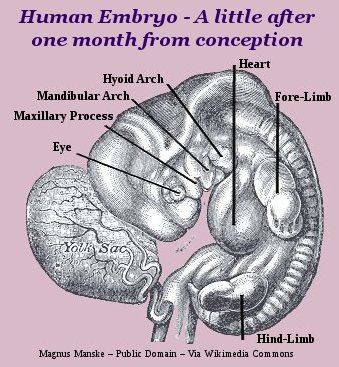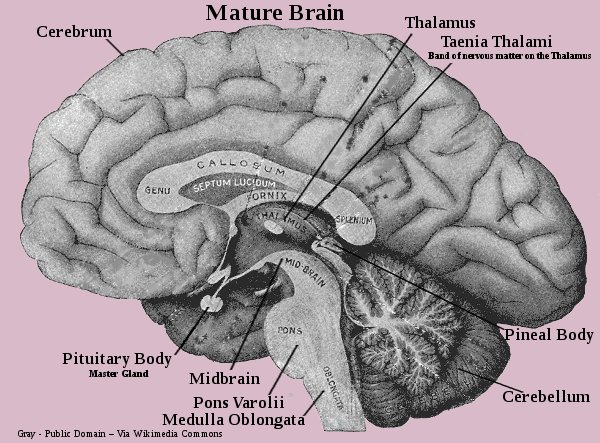The
Human Brain Structure Is Possibly Nature's
Most Admirable
Accomplishment
Part 2 - Part 1
The Complex Human Brain Structure
The Human Brain structure is quite possibly Nature's foremost admirable accomplishment. if a touch enigmatic. You are studying the most complex construction, that we are aware of, in the Universe. In being so complex, your Brain demands much attention and concentration to understand it.
When this author's capacity to understand - anything - is challenged, he recalls Ralph Waldo Emerson's wise observation . . .
How calmly and genially the mind apprehends, one after another, the Laws of Physics!
Then he goes about calmly and genially, apprehending whatever subject may be threatening to confound him. With Emerson's observation in mind, let's show the Brain who is in charge.
In an attempt to hasten familiarity with this subject, the descriptive terms, and components, belonging to the discipline of Neurology, are presented in bold type.
Meet Your Brain
Your Brain - Encephalon - is the concentration - Cephalization - of your Nervous System at the top of your Spinal Cord, consisting of many subsystems, that evolved over hundreds of millions of years.
Beginning immediately after Conception, the initial part of a Human Embryo to take shape is this Central Nervous System.
Embryonic cell division then constructs a Neural Tube, shown above in green, from which originates the three Primary Divisions of the Brain, and is recognizable as a Brain and Spinal Cord a little after one month.
The following two images emphasize the phenomenal growth of the Human fetus in such a short time span.


Human Embryo
These three Primary Divisions of the Human Brain originating in the Neural Tube shown in green, in the top image, grow and expand to become
the Brain structure, as follows:
Forebrain
The Proencephalon, otherwise known as the more easily remembered Forebrain, is made up of two divisions.
These two divisions are respectively referred to as the Diencephalon and Telencephalon.
The Diencephalon, or Interbrain, is also referred to as the Thalamencephalon.
The Thalami, Pituitary Gland, and Pineal Gland or Body, are considered part of the Diencephalon.
The Telencephalon matures into Evolution's cardinal recent addition, the Cerebrum. The Cerebrum by far is the largest segment of the Human Brain structure.
The Telencephalon is the most advanced component of the Human Brain, and happens to be this author's favorite element. Favorite because it provides you and me with the necessary faculties to take charge of our Mind - via our Thinking ability - and function in a wise civilized fashion, while we go about one's business of accomplishing our personal, and collective, aims. In an enlightened manner.
It is this segment of the Brain, and it's major function, the ability to process information - in an enlightened manner - that pdThinker.com is most focused on.
Midbrain And Brainstem
That beak-like tip of the Brainstem, the Midbrain, serves as the connecting link between the Forebrain and the Hindbrain.
This is probably the easiest part of our Brain to remember!

The Evolutionary earliest
subsystem of the Brain structure to develop was the Brainstem,
composed of the Midbrain,
Pons Varolii
and Medulla Oblongata. Humans share this primitive structure with most other creatures.
The Pons Varolii is a small swelling towards the top of the Brainstem, connecting the Midbrain to the Cerebellum and the upside down pyramid shaped Medulla Oblongata, which merges with the Spinal Cord.
Your Spinal Cord's conductive pathway is constructed in a similar fashion to the Cerebral
Cortex. Composed of a core of Grey Matter encircled by White Matter, it also consists of bundles of nerve cells that carry messages to and from the Brain to every part of the body.
In conjunction with the Cerebral Cortex, the Spinal Cord provides a protective distributive highway for, and completes, the extensive physical circuitry of the Human Central Nervous System.
Hindbrain
The Hindbrain is constructed from the Cerebellum, Pons Varolii, and the Medulla Oblongata.
Cerebrum
The Cerebrum is the most highly developed component, and forms the bulk - more than eighty percent - of the Human Brain structure.
As a motorcyclist's helmet covers the exterior of the wearer's head, the Cerebrum envelops the entire Brain. Except for the Cerebellum. The Cerebellum is tucked away beneath the Occipital Lobe.
The Cerebrum is composed of two identical Cerebral Hemispheres, left and right, detached longitudinally, but connected at the base by a mass of Nerve Fibers known as the Corpus Callosum, (Latin for callous body), the means by which the two halves communicate. Each half controls the opposite side of the body.
The evolutionary recent Telencephalon is further divided into the Rhinencephalon, home to the Rhinencephala, or Olfactory Bulbs, - sense of smell - the Corpus Striatum, of which the Basal ganglia form a part, and the Neopallium (Neocortex)
In conjunction with the Cerebellum and Basal Ganglia, the Cerebrum is involved with all voluntary bodily action.
The most ancient part, of the Telencephalon, the Rhinencephala, depicted by red stripes in image above, are rudimentary in Humans compared to other animals. However this does not appear to detract from a keen sense of smell, as any person who employs their nose in a professional capacity will attest.
Maybe, the skill of odor detection and discrimination, like all competent use of the Brain, lies in awareness. This should give us hope for the civilized development of our Neocortex, the most recent part, which is delivered to us already at the evolutionary cutting edge.
Neocortex
The Neocortex is an expansion, or thickening, of the Cerebral Cortex, permitting greater Quantity and density of Neurons. Once again, wherever we find Neurons, we find Potential Intelligence.
It is how we utilize this part of the Brain that defines us as Human Beings, and by extension, individual Human Beings. This super mighty apparatus is the core of your Voluntary Nervous System, grounded in Free Will.
The Human Brain structure Rocks!
Part 2 - Part 1









